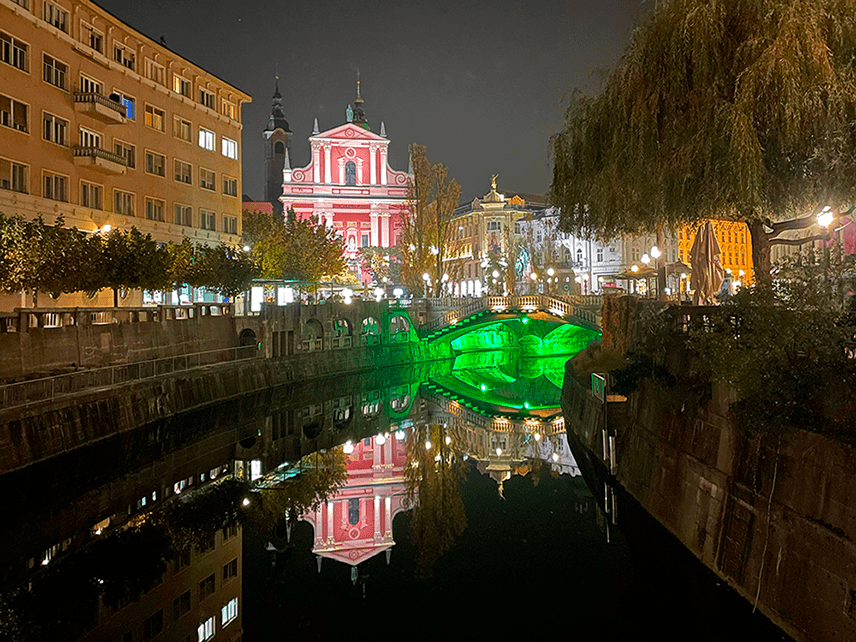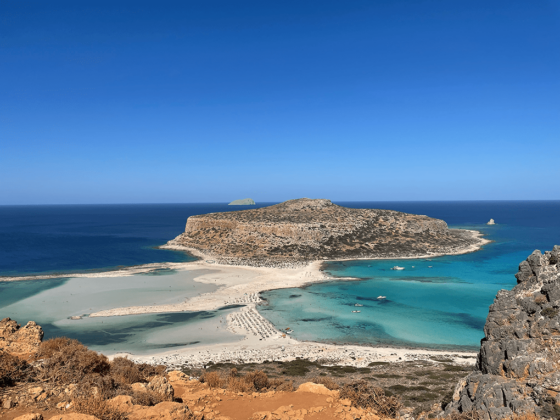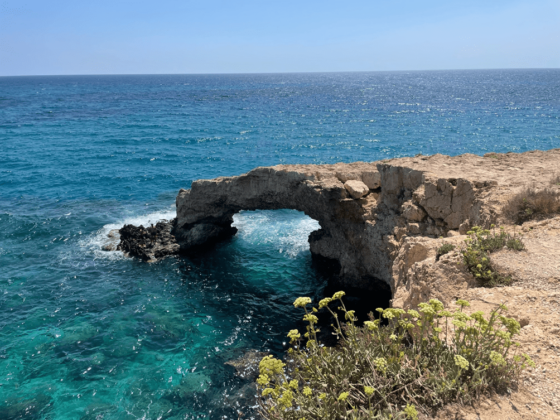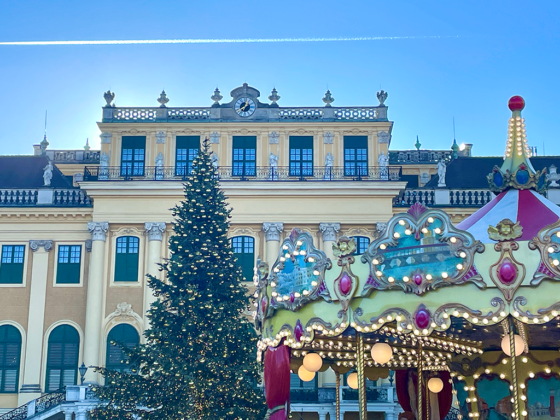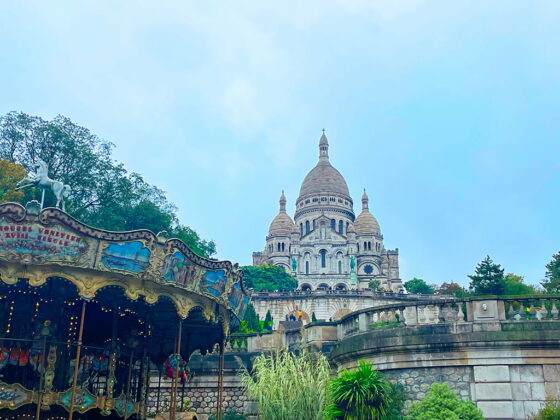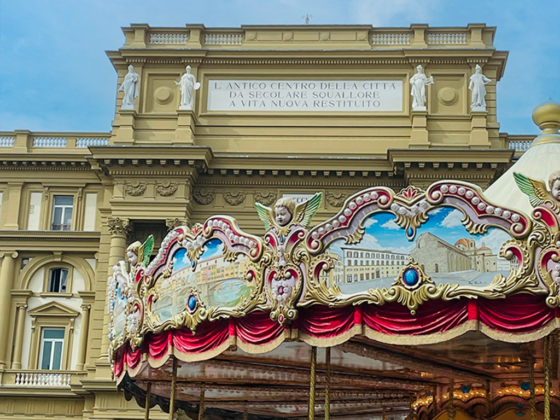Ljubljana is Slovenia’s largest and most populous city and its capital. It is certainly a city on a human scale with a completely traffic-free historic centre and plenty of green areas around it. It holds the title of ‘Green Capital of Europe’, a well-deserved award for having succeeded in reducing private car traffic and increasing public transport and pedestrian traffic.
We visited in autumn and the colours of nature left us speechless, but the impression is that it is a trip that can be made at any time of the year, to discover new colours.
Our 1250 km long bridge lasted five days. If you are curious to find out more, here are the stages it consisted of.
Map
Day 1: Historic Centre
We left late in the morning, the early part of the classic first day of travel for Paolino, who had not yet got into the holiday mood. After five hours on the road, greasy sandwiches in the car, off-key songs, and the usual roadworks (I think the same ones we found five years earlier on our way to Croatia), we arrive at our destination when it is already dark.
Tips for Trips: To drive on the motorway in Slovenia you need to buy a vignette, a square-shaped sticker made up of two parts, a small sticker which must be removed and kept, and an upper, sticky part which must be displayed prominently on the windscreen. This can be found at petrol stations in Slovenia and neighbouring countries and has different durations, we opted for the weekly vignette. The validity of the six-monthly, monthly and weekly vignette is indicated by a hole punched in the vignette by the dealer himself.
Our room is in the city centre, a few steps from the Dragon Bridge, the city’s landmark. From the window, we look out onto the outdoor tables of the cafés in the street below us (despite the unfriendly weather, they are packed with people and festively lit). The Ljubljanica River flows just a few metres away and in front of it we can see the characteristic Central Market across the Butchers’ Bridge adorned with modern sculptures but also with padlocks tied to the balustrades (apparently it has been awarded the title of ‘Bridge of Love’ by the local boys).
Day 2: Vintgar Gorge, Šum Waterfalls and Lake Bled
We move on from Ljubljana, there are some wonderful excursions we cannot miss, natural beauties that close their gates to tourists in November, so we take advantage of these last days of October.
The first stop, 50 minutes from Ljubljana, is the Vintgar Gorge. At 1.6 km long, it winds its way between the high vertical walls of the Hom and Boršt mountains and is carved by the Radovna River, forming waterfalls and rapids. The gorge is crossed by a footpath on wooden bridges. Needless to say, with the colours of autumn overpowering and intense, the landscape leaves us speechless… we immerse ourselves in nature and even the cold no longer seems so biting.
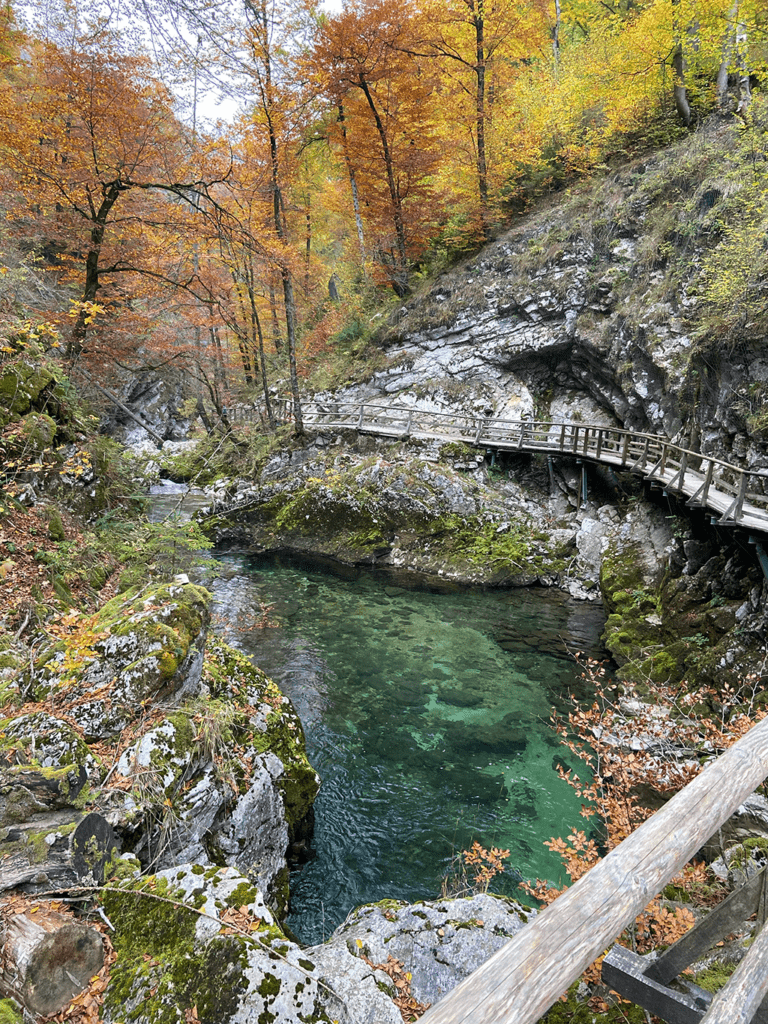
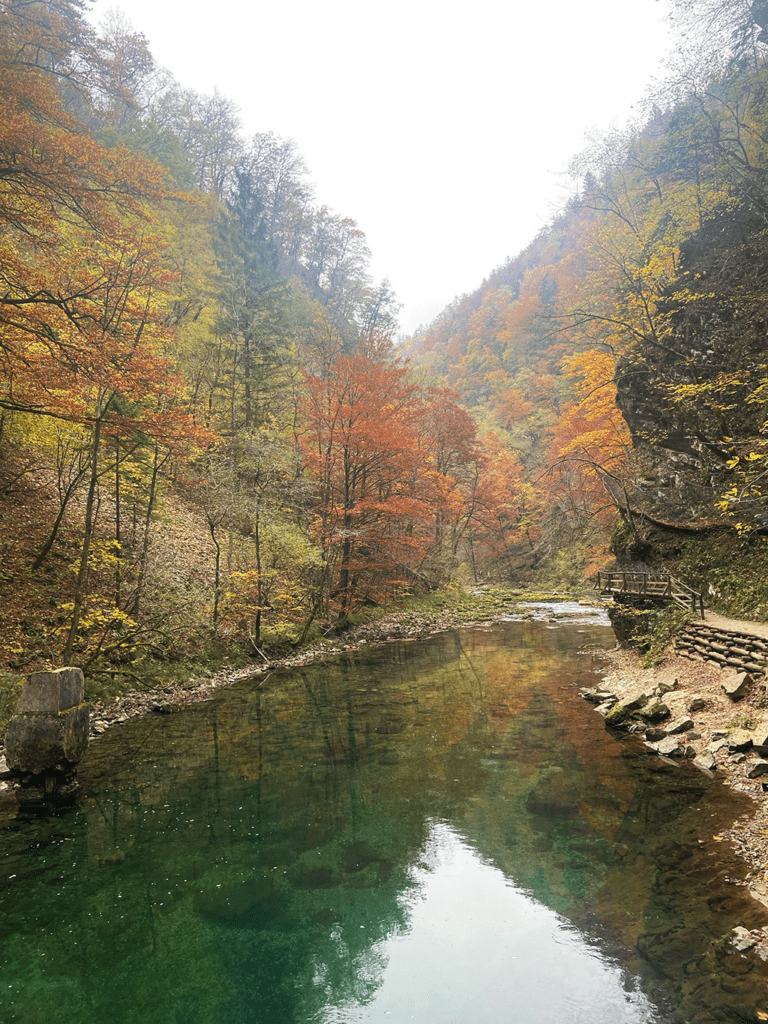
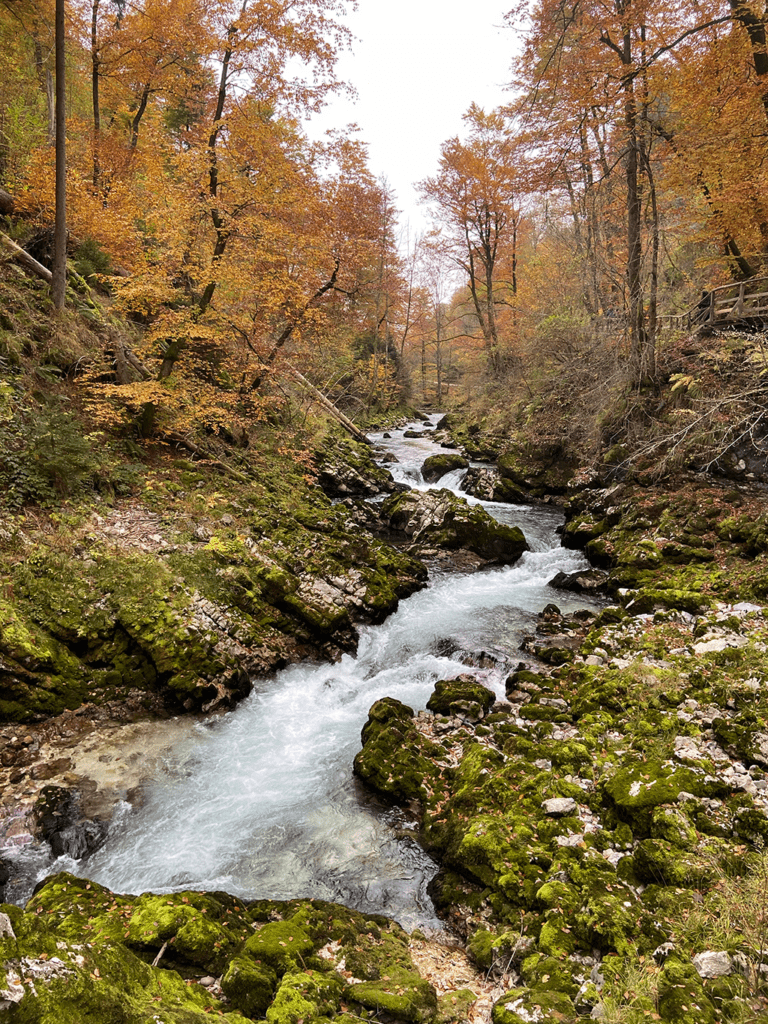
At the end of the trail, about 1.5 kilometres from the entrance, we find a majestic single-arch stone bridge: this is the Old Bohinj Railway Bridge, a full 33.5 metres high and 65 metres long. It was built between 1904 and 1905 and today is the largest stone arch railway bridge still preserved in its entirety on Slovenian territory.
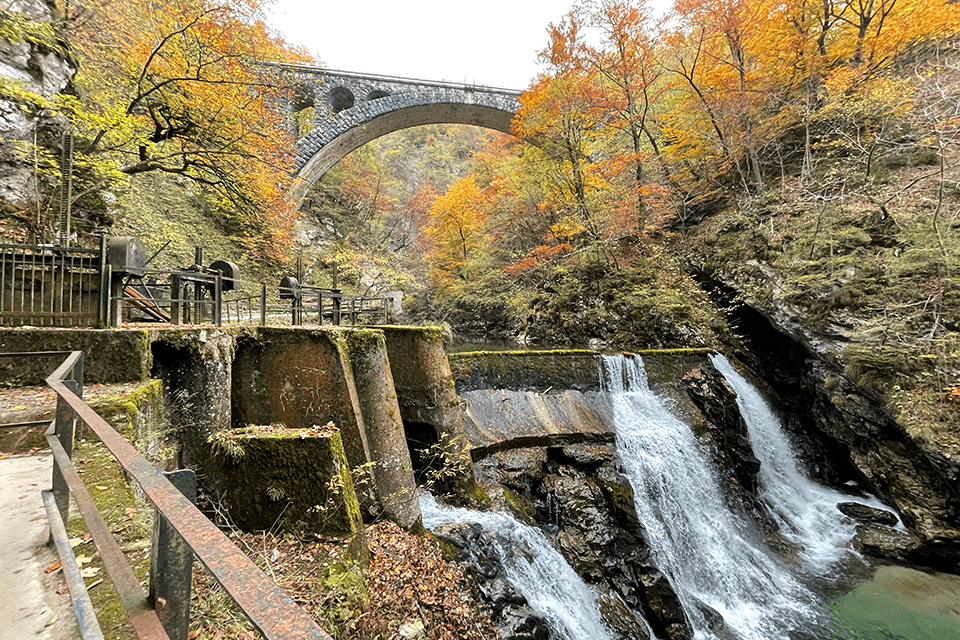
Once past the exit turnstile, we find ourselves in front of the bar. At the back is a steep staircase that descends to a small valley. At the bottom of the staircase are signs for the spectacular Šum Waterfall: this is the same stream that flows through the Gorge, which rushes on its way. Below the waterfall there is also a small hydroelectric power station, which is not visible, however.
From here, there are two different routes back to the entrance. If you continue past the Šum waterfall in a south-easterly direction up Mount Hom, you can reach the picturesque church dedicated to St Katarina above the village of Zasip. From here, you can enjoy a splendid panorama of the Karavanke range, the Julian Alps, including Triglav, and the Bled valley. The second route (or continuation of the first) passes through the village of Blejska Dobrava. Turning left past the Šum waterfall and crossing the bridge, one proceeds along a steep flight of steps that leads quickly upwards to the village of Blejska Dobrava. Continuing along the asphalt road past the houses to the end of the village, we come to a forest path that leads back to the log cabin at the entrance to the gorge.
For lunch, we move on to Lake Bled, in the south-west, the part closest to the island of the same name. As soon as we arrive, a real picture postcard landscape opens up in a fairytale atmosphere. In the centre of the lake is the small Bled Island, Slovenia’s only natural island, which is said to stand where a temple dedicated to Živa, the pagan goddess of life and fertility, once stood. Several buildings stand on the island, including the baroque Church of the Assumption and the Provost’s House, now a museum. There is also a long staircase of 99 steps on the southern shore. According to a popular tradition, on the day of the wedding, the groom must walk down it holding his bride in his arms to ensure that the wedding has good luck.
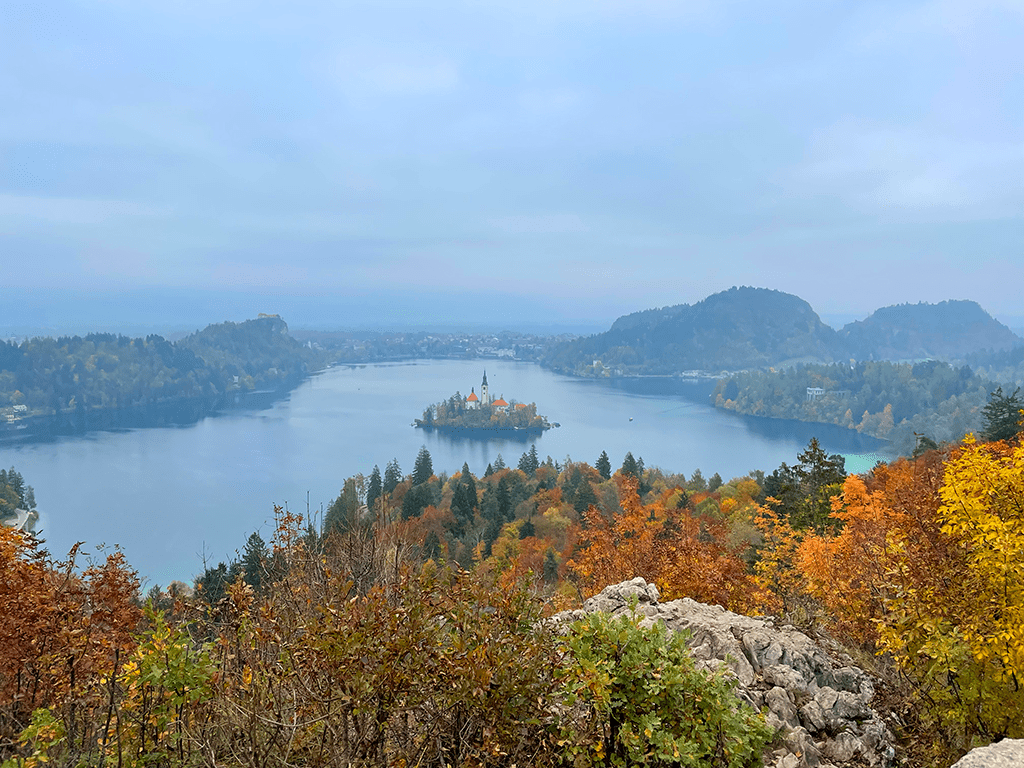
I loved the story of its birth: In ancient times, on the spot where the lake stands today, there was no water but a grassy valley and a mound with a rock around which fairies danced at night. In that valley, shepherds grazed their flocks around the fairy rock. The fairies asked the shepherds to fence off the area where they danced, so that the soft grass would never fail. The shepherds ignored their request, until one day the youngest and most beautiful fairy, while dancing, tripped and broke her foot. The fairies, furious, summoned all the mountain streams that rushed into the valley and flooded it. In the centre of the lake only the mountain with the rock remained, on which, from then on, the fairies could dance undisturbed. Thus Lake Bled was born.
After wandering around the lake, we couldn’t miss the trekking route to the Ojstrica viewpoint (there are actually three viewpoints – Ojstrica, Mala Osojnica and Velika Osojnica – but the compromise was to choose one… to Paulinus’ chagrin, I chose the most inaccessible).
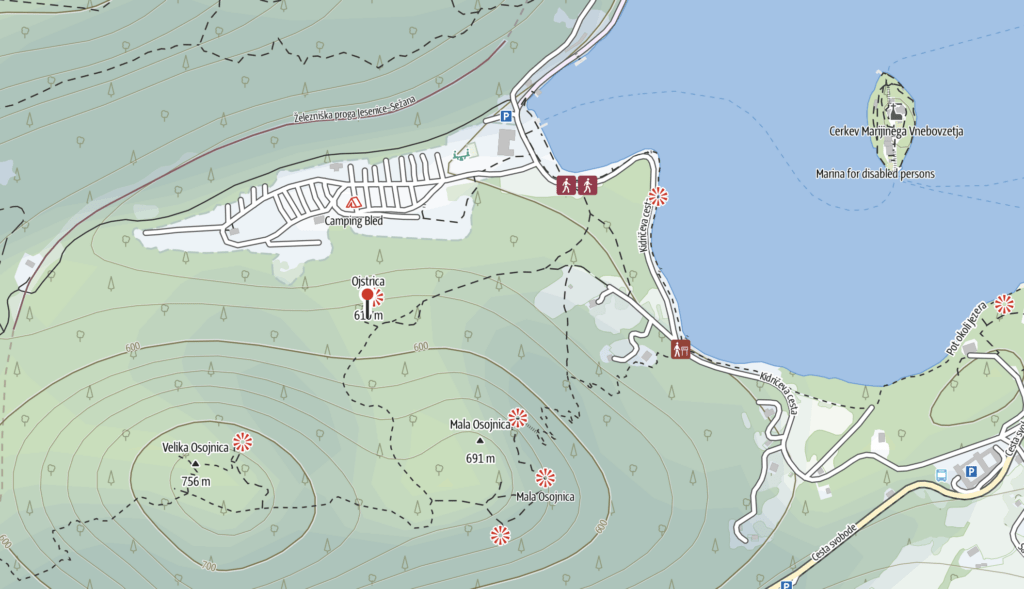
The route involves an approximately 35-minute ascent to Ojstrica, the peak of a mountain 610 metres above sea level, from which one can dominate the lake, the island and the entire valley. The path is number 6 and starts at the lakeside, about 100 metres from the campsite. The path is all uphill, but within the forest. The main section is wide but a little uneven due to the many stones present. A signpost indicates a diversion to the right, for the final ramp up the rocks, where a metal rope has been installed to help with the tricky part. After this final effort, you reach the summit from where the view of the lake and surrounding mountains is superlative.
North of the lake, perched on a 130-metre-high rock, is Bled Castle, one of the oldest fortresses in Slovenia, whose origins date back to the Middle Ages. The castle can be reached via several footpaths that start in the centre of Bled and wind through the forest to the summit, or by car via an asphalt road. We read a few reviews, not all of them positive, and decide to skip the visit to enjoy the relaxation of the lake a little longer.
Day 3: Predjama Castle and Postojna Cave
Also early today, we have a 50-minute drive to Predjama where, embedded in the rock, is Predjama Castle, the largest castle in the world built inside a cave, perched on an outcrop on a 123-metre high rock face.
Legend has it that the castle became the hideout of the brigand knight Erasmus of Predjama, who resisted the sieges of the imperial army of Frederick III of Habsburg for a year and a day. He took advantage of the network of underground tunnels connecting the castle to the Lokva stream to move about in secret, escape and to receive supplies during sieges. The army eventually succeeded in striking Erasmus thanks to a suggestion by a corrupt servant who gave the signal to the enemy troops to hit him with a stone bullet just as he was sitting on the toilet. Erasmus was buried under the square in Predjama, next to the small 15th century church where an imposing lime tree planted by Erasmus’ beloved in his memory still grows today.
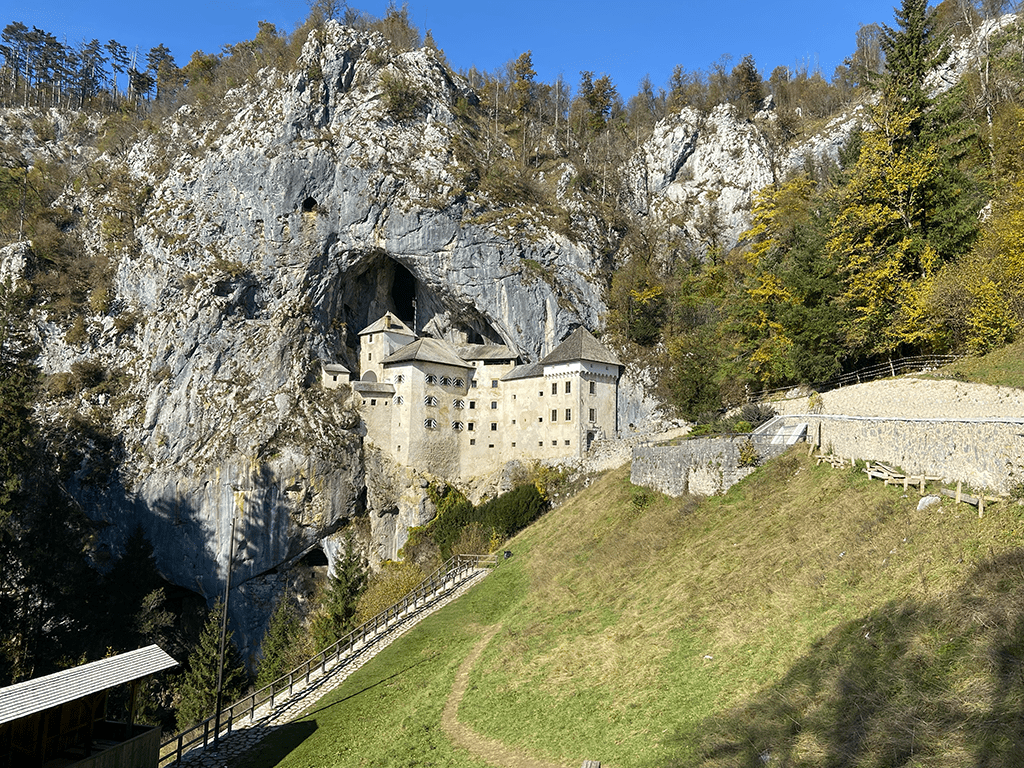
The interior of the castle is very simple and the rooms are arranged on several levels and furnished in the style of the period. We visit the chapel, the dungeons, the torture chamber, the latrine where Erasmus was killed according to legend, the knight’s rooms, the armoury and the ‘Erasmus’ den’. The latter is the most atmospheric part of the castle. It is located in the upper part of the structure and was used as a refuge and a shelter for storing food. It was also an excellent vantage point over the valley and the village below.
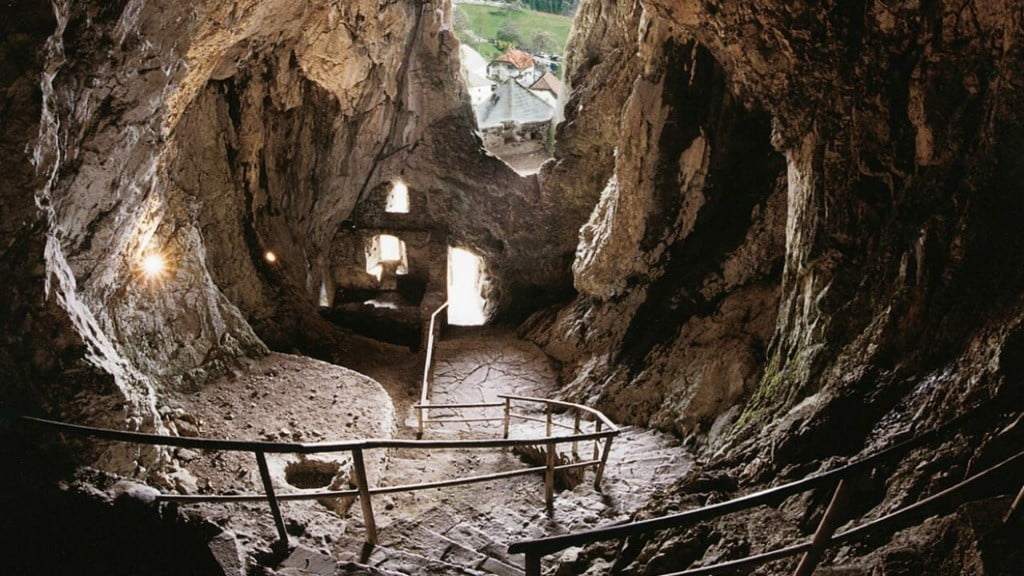
Unfortunately, we have to forego a visit to the caves under the castle because during the winter period they become home to hibernating bats and are therefore closed to the public, who can only access them from May to September.
We move on to the Postojna Caves for the trek ‘Through the Three Caves’, the most eagerly awaited stage of this trip.
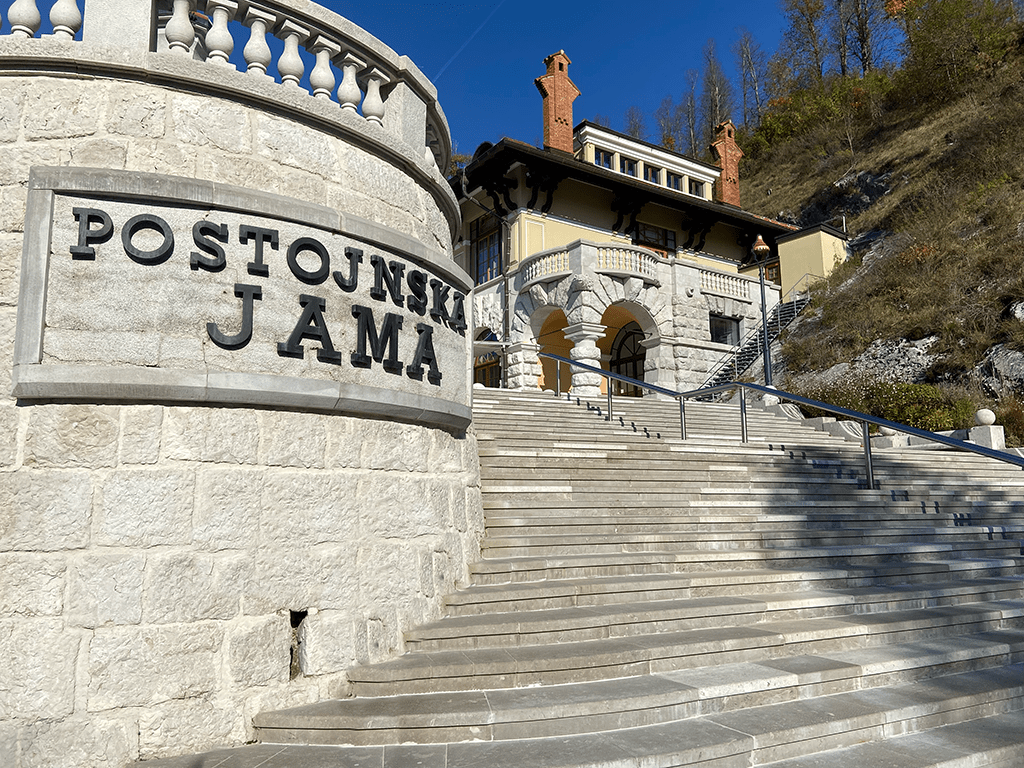
In the period between World War I and World War II, when the Postojna territory belonged to Italy, three caves of the Postojna cave system were connected by artificial tunnels: the Postojna Caves, the Black Cave and thePivka Abyss. This long complex of artificial tunnels ensures easy passage from one cave to the next.
The trek takes about three hours and has a low level of difficulty. Part of the route is taken by the special little train that leads to the heart of the Postojna Cave. We visit the spaghetti room, so called because small, white, almost transparent tubes of calcite descend from the ceiling like spaghetti. Through an artificially excavated cave, we move into the Black Cave and climb up to the surface. We cross a forest path and then descend into the heart of the caves through the Pivka Abyss. We return to the Postojna Cave. We pass the White Hall, which owes its name to white calcite, and admire the Brillante, a five-metre-high column that has become the symbol of the caves. We arrive at the Concert Hall, one of the largest halls in the cave system and used for concerts for several years, and finally we enter the Congress Hall.
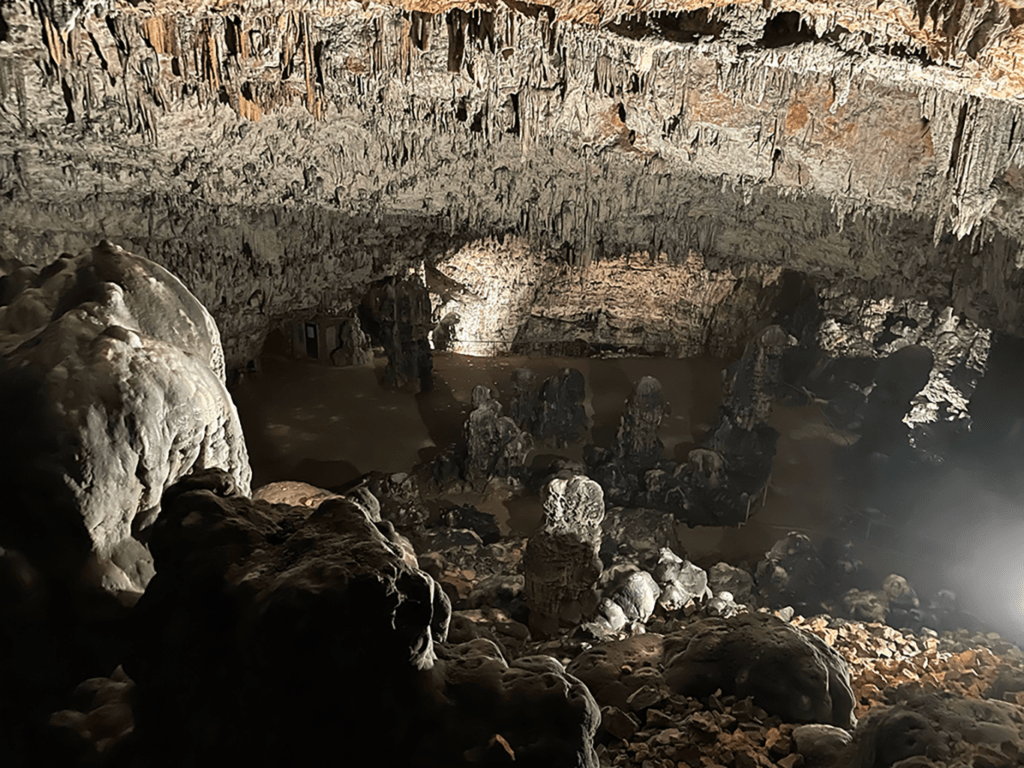
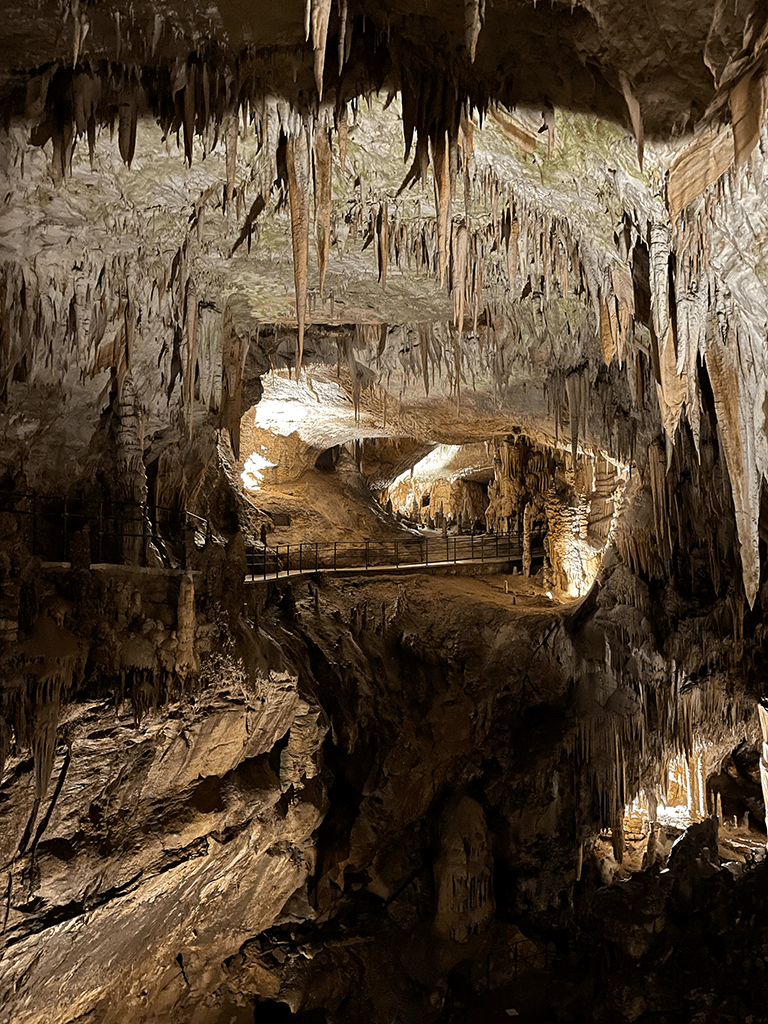
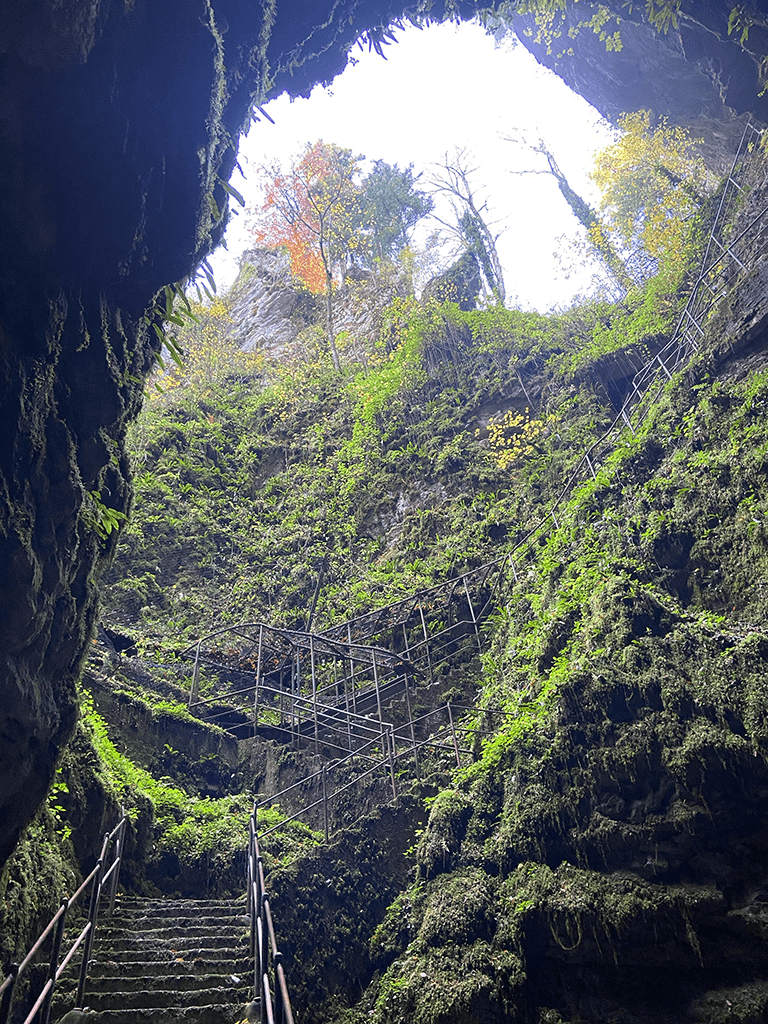
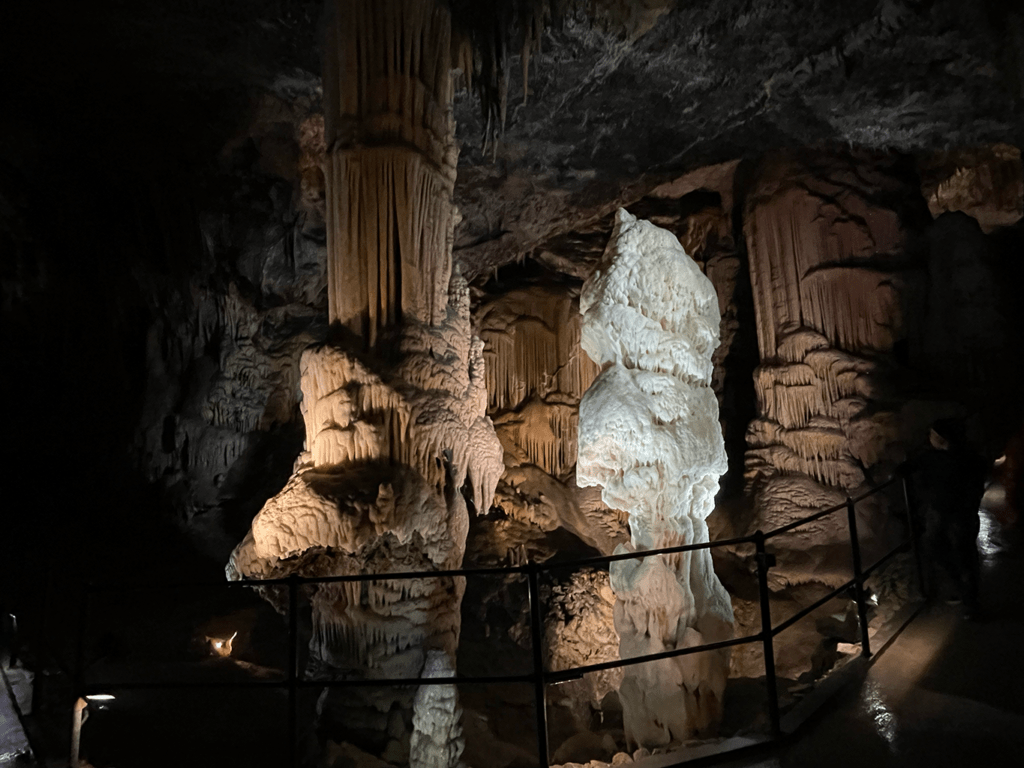
On the way out, we can visit the Vivao Proteus where we meet the famous cave mascot: the proteus, the small dragon, the only vertebrate animal in Europe to have such a close connection with the underground world. It is considered a neotenic animal, i.e. it retains even as an adult the same physical characteristics it has as a pup. It is adorable!
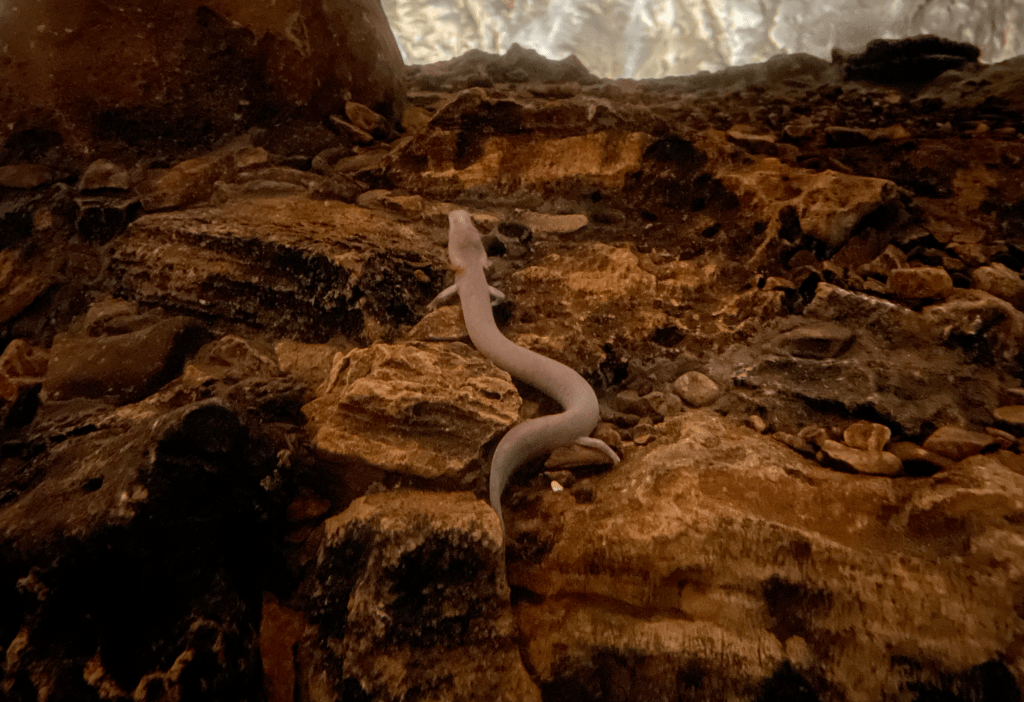
Day 4: Tivoli Park, Ljubljana Castle and Metelkova
Today we dedicate the whole day to Ljubljana. Although we explored the centre quite a bit during the evening walks, a broader tour around the city, strictly on foot, is not to be missed.
We begin with the famous Tivoli Park, the largest green area in the city, which grew out of several parks surrounding Podturn Castle and Cekinov Grad Palace. The park covers about 5 km2 and is divided by three avenues of chestnut trees. The main feature of the park is the picturesque Jakopič Promenade (named after the Slovenian impressionist painter Rihard Jakopič and redesigned by Plečnik in 1934), which hosts exhibitions of large-format photographs that can be viewed outdoors every day of the year.
The walk leads to the 17th-century Tivoli Castle, guarded by four dog sculptures, which today houses the Tivoli Gallery – International Centre for Graphic Art. The park complex then features a pond, a small botanical garden, created in 1880, and an outdoor Olympic-size swimming pool, built in the 1930s together with sports fields, a children’s playground and a sports hall.

We stroll through the park with its geometric paths, tree-lined avenues and gardens adorned with numerous statues and fountains and stop to play with some of the local animals (it took a while but, to Paolino’s delight, we made friends).
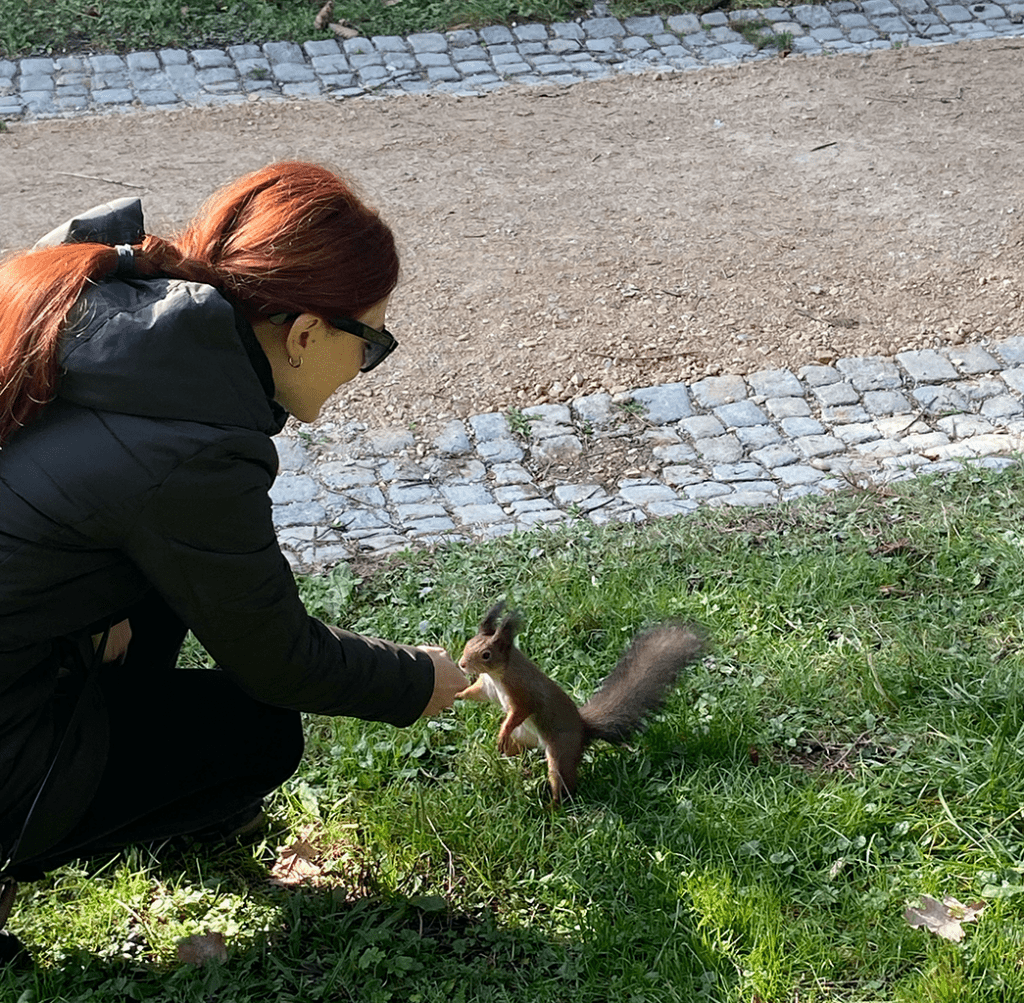
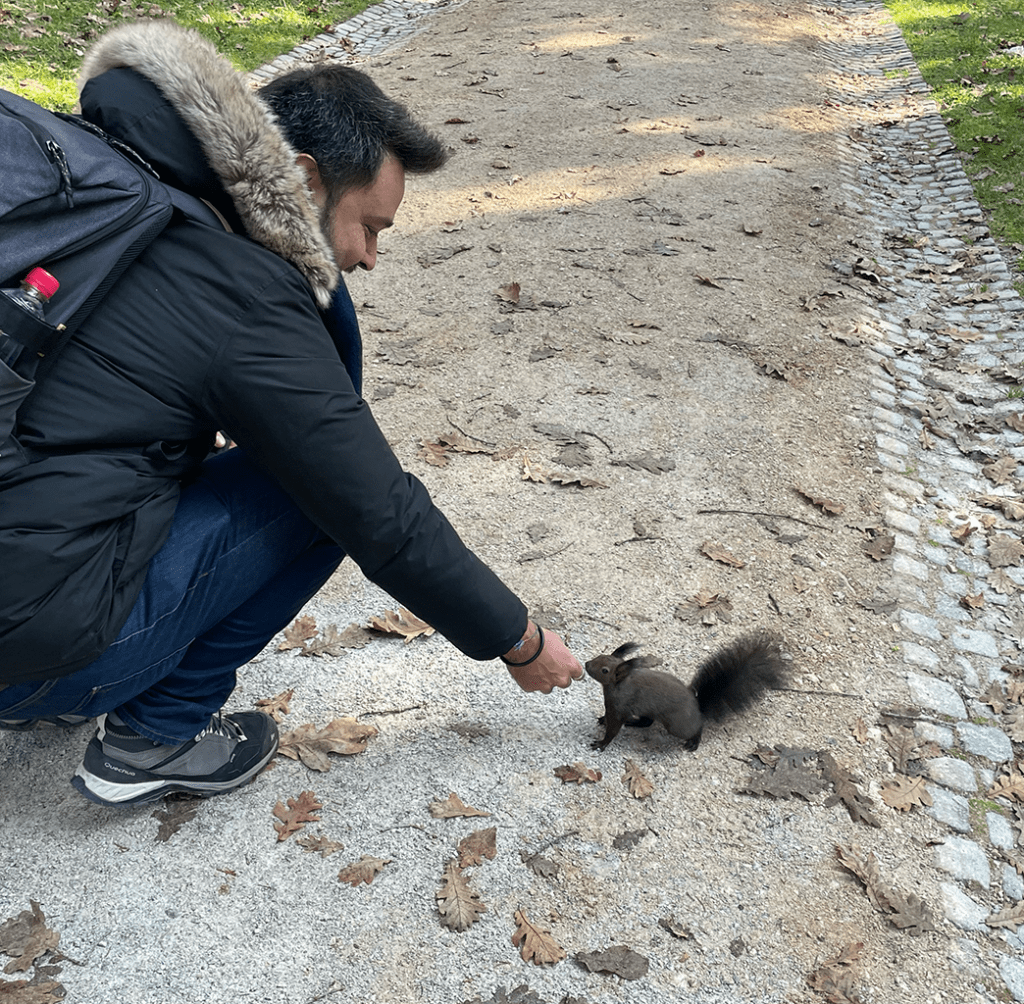
We move towards the centre, now as if we were locals (about…) and just outside we stroll along Miklošičeva cesta, a street in which there are several Art Nouveau buildings with unusual shapes and decorations. Prominent among these are the Vurnikova hiša, the most famous and unmistakable building with its pink façade and geometric decorations in the colours of the Slovenian tricolour, the Grand Hotel Union, elegant in its soft forms, and theHauptmann House decorated with coloured tiles in geometric patterns.
And here we are at Prešeren Square, the crossroads of an irregularly shaped river of people, always ablaze with music. It is dedicated to Slovenia’s greatest Romantic poet, France Prešeren (1800-1849). His poem, Zdravljica (‘Toast’) provided Slovenia with the words of its national anthem. The statue of the poet, erected in 1905, is surrounded by Art Nouveau façades and the Franciscan Church of the Annunciation, built in the Baroque style in 1646-1660.
Opposite is the Triple Bridge spanning the Ljubljanica, the nerve centre of Ljubljana, where street artists and musicians enliven the days of tourists. This bridge, now completely pedestrianised, was originally a simple stone bridge, but due to increased traffic, two other pedestrian bridges were added to flank the existing one.
We cross the bridge and follow the road for 200 metres until we come to the Civic Square, the heart of Ljubljana’s old town and dotted with elegant buildings: the Haman House, which houses the Mestna Galerija(City Gallery), the elegant Lichtenberg Palace and the City Hall, which dominates the Civic Square with its Clock Tower. In the centre, opposite the Town Hall stands the obelisk of the Carniolan Rivers Fountain (1751), a Baroque work by the sculptor Francesco Robba. The three statues holding vessels from which the water flows represent the three Carniolan rivers: Krka, Ljubljanica and Sava.
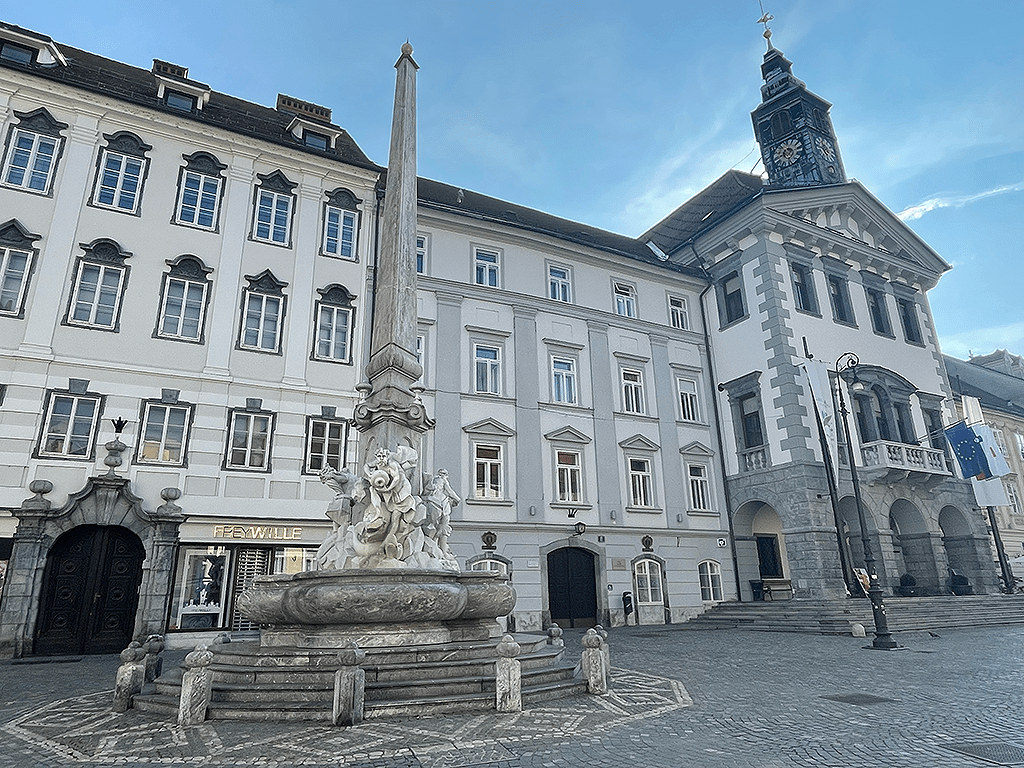
A few steps from Piazza Civica stand the two towers and green dome of St Nicholas Cathedral. The cathedral, designed by architect Andrea Pozzo, stands on the remains of a Romanesque basilica and contrasts the linearity of the exterior with the Baroque style of the interior, in pink marble and rich in frescoes, sculptures and white and gold decorations. Notable works inside include paintings by Giulio Quaglio depicting the life of St Nicholas, sculptures of the four bishops of Emona by Angelo Putti and altar angels by Francesco Robba. Finally, the extraordinary bronze portal with the history of Slovenia and the side portal with the sculpted faces of the bishops of Ljubljana should be noted.
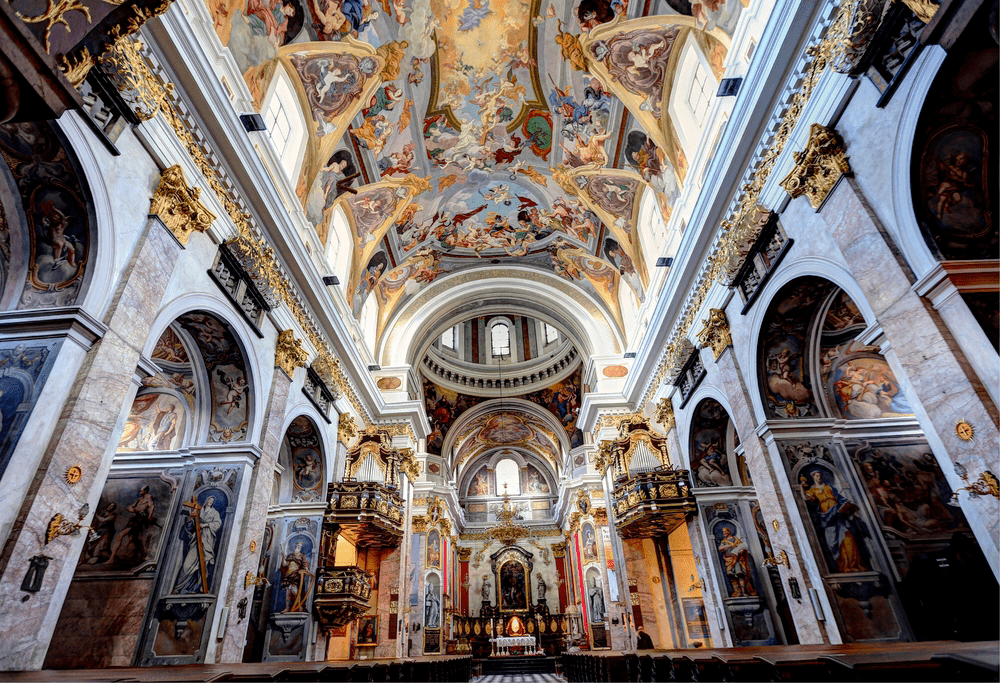
Lunchtime arrives and we find ourselves at the world-famous Central Market, a meeting point for the people of Ljubljana, which includes the open-air market on Vodnikov and Pogačarjev Squares, the covered market between the two squares and the Plečnik covered market along the Ljubljanica River. The open-air market is very characteristic and full of intense colours and scents. You can find typical Slovenian products, flowers, meat, fruit, clothing and plenty of classic tourist souvenirs. The covered market under the Plečnik colonnades (designed by the architect Plečnik) is divided into two floors. On the upper floor are restaurants and shops selling typical Slovenian products. On the lower floor is a fish market with a small restaurant and the DobraVaga art gallery.
We are ready, backpack on our shoulders and set off for Ljubljana Castle… but by funicular! The castle can also be reached on foot, with a route of about 800 metres uphill starting from the Dragon Bridge, we enjoy it but downhill.
The medieval-style castle dominates the Slovenian capital from the top of the hill. Built on the site of a Roman fortified camp, it was destroyed by an earthquake in 1511 and later rebuilt. It was the seat of regional power and later a prison. The present castle, with the exception of the Gothic chapel (1489), is a late reconstruction of what it once was but offers, from the crenellated tower, a wide panorama of the town and surrounding mountains. Such a view is not to be missed.
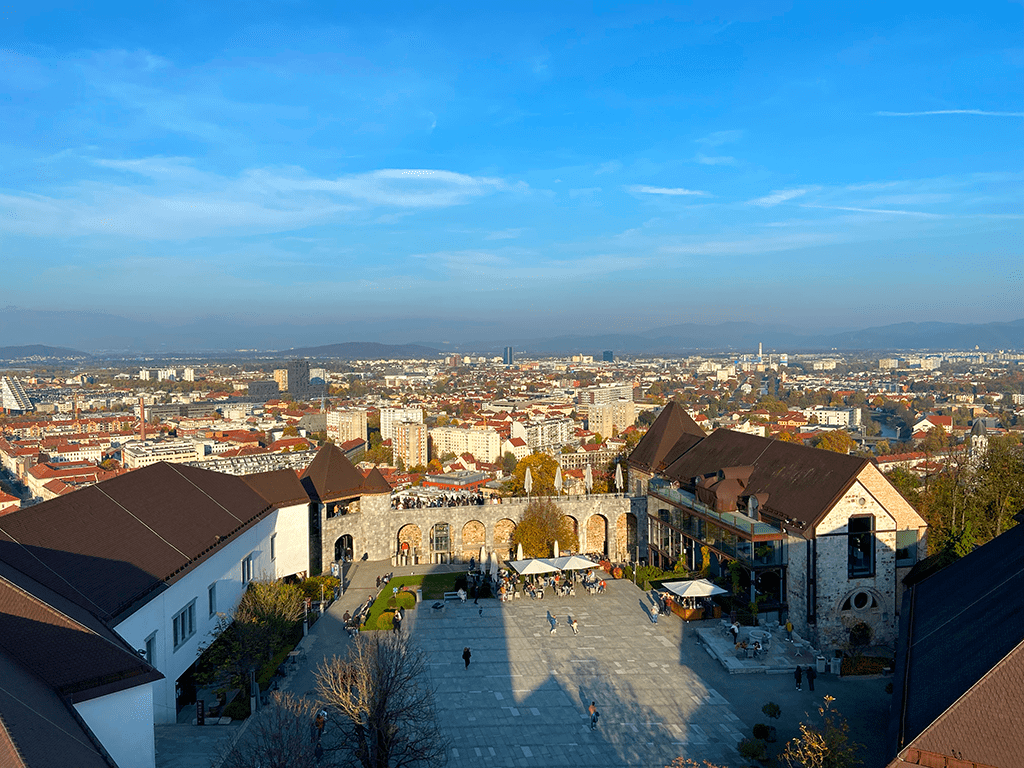
We walk down and enjoy a piece of the forest. We pass by the world-famous Dragon Bridge, which spans the Ljublianjca River, and stop for a few photos. The bridge, made of reinforced concrete, was built in 1900 to replace the older, wooden Butcher’s Bridge. There are four fierce-looking winged dragons (made of copper) at the entrances to the bridge, one on each side. The dragon, the symbol of the city, is based on the famous legend of Jason who, after gaining possession of the Golden Fleece, killed the dragon that lived in the marshes around the mouth of the Ljubljanica River. The dragon also features on the city’s coat of arms.
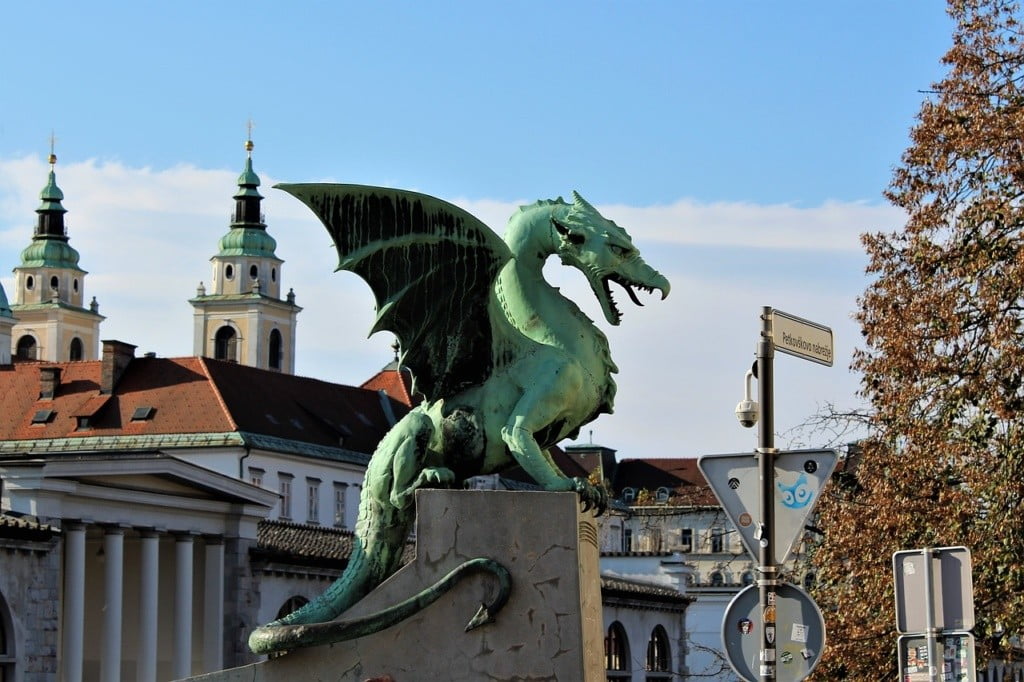
Just a few minutes’ walk from the centre of Ljubljana took over Metelkova, which was created from an abandoned military barracks and occupied in 1993 by the Rete per Metelkova group. It was an association of artists and intellectuals that transformed it into the free, self-managed and constantly changing area that is still active today. Metelkova is a very characteristic autonomous cultural centre. It is full of graffiti, colours, special structures and art installations. Art galleries, designer studios, bars, music clubs with concerts of music from all over the world and exhibitions can be found here. In the district you can also stay in a very special hostel, the Celica Hostel, housed in a converted ex-military prison where each ‘cell’ is unique and different from the others.
We arrive after Halloween night and find it practically deserted but still manage to appreciate its eclectic style. It is definitely an alternative destination worth a visit.
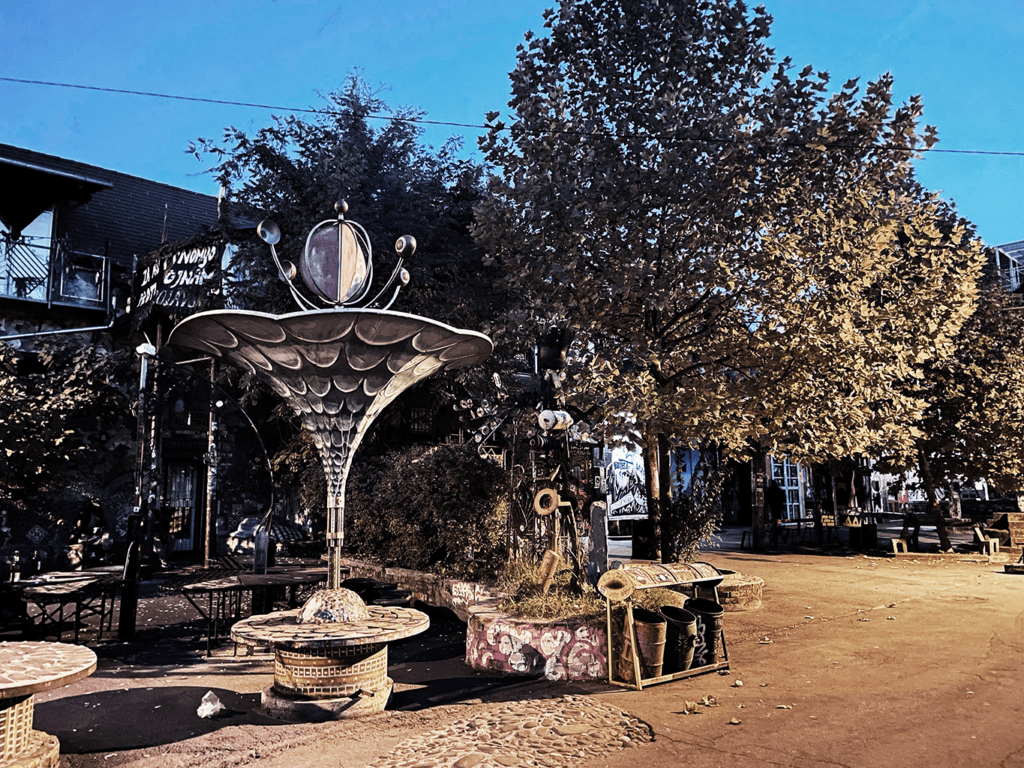
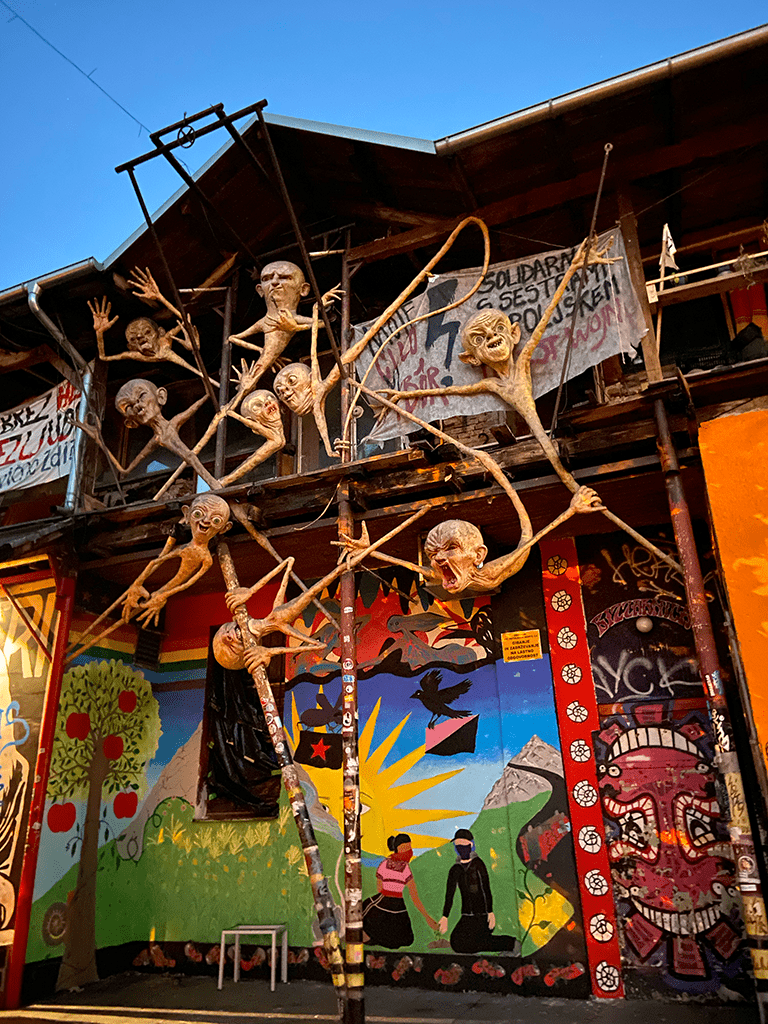
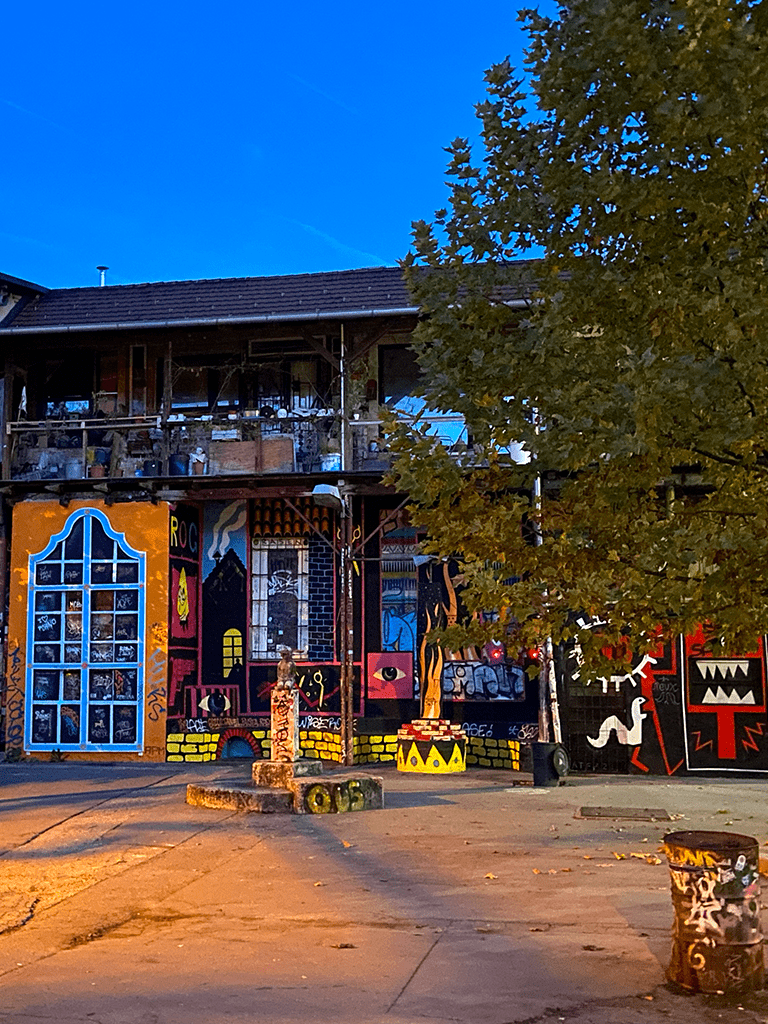
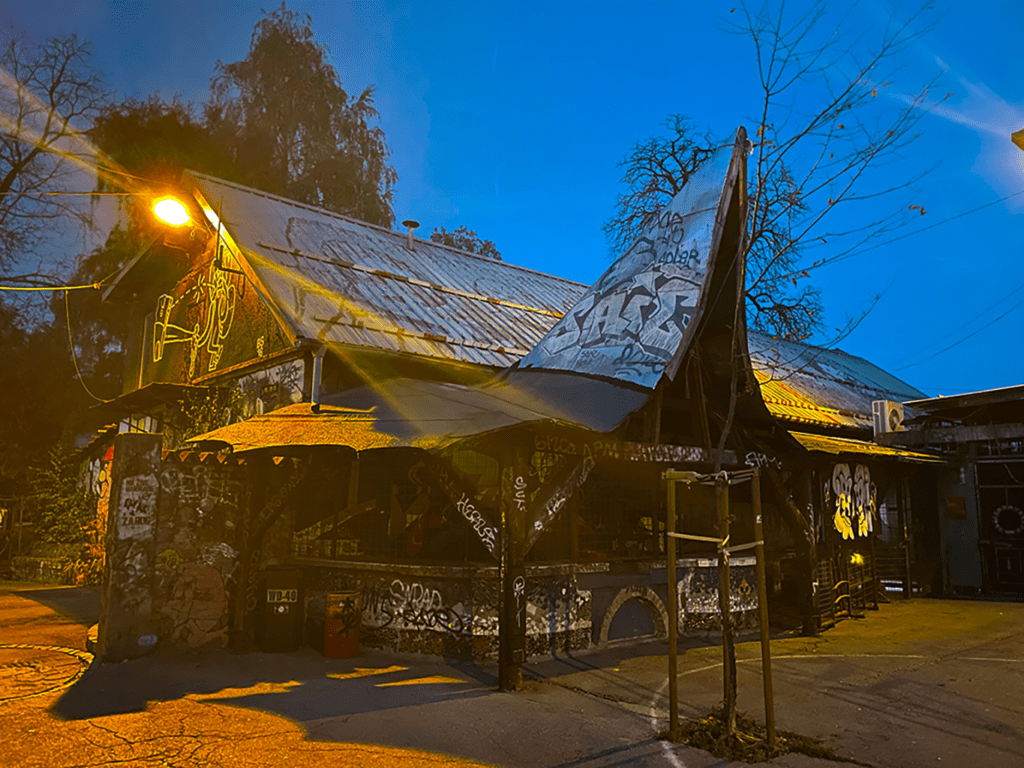
We head back towards the centre and after this long day we treat ourselves to a good dinner in a typical restaurant. After dinner, we can’t miss a walk along the riverbank and a digestif in one of the open-air restaurants (with a chair attached to the stove, of course).
Day 5: Return
Today we return, we have a bit of a drive ahead of us, but we break up the journey with a stop in the Venice area for lunch at a very quaint agriturismo. Main topic: a tour of Slovenia in summer, there are plenty of routes through the countryside that intrigue us!
Last modified: 12 April 2025
